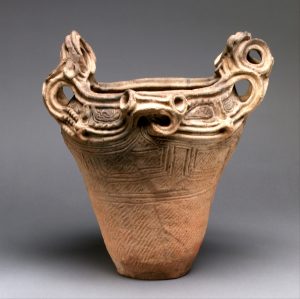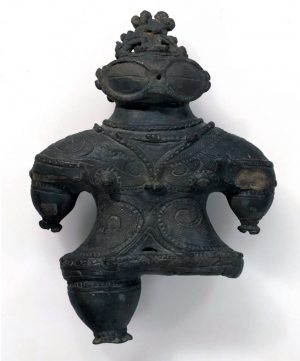Japanese Pottery

“Flame-rimmed” deep bowl, Middle Jōmon period (c. 3500–2500 B.C.E.), earthenware with cord-marked and incised decoration, 13 inches tall (The Metropolitan Museum of Art)
During my first blog post I really focused on some Korean pottery dealing specifically with the celadon style of pottery. What I am focusing on in this blog post has to deal with the Japanese and what they did during the Jōmon period. During this time most of the people in this culture got their food by gathering, hunting, and fishing as well as they liked to migrate to cooler and/or warmer places due to climate change. The reason why this period is known as the Jōmon period is because the word “Jōmon” means ““cord pattern,” which refers to the technique of decorating Jōmon-period pottery.” According to smart history. During this time typically the women would make the pots and pieces by hand. They did this by creating coils and building from the bottom up of the vessels with materials consisting of wet clay mixed with mica and crushed shells. Once the pottery piece was constructed, they then smoothed out the piece inside and out and then decorated them with geometric designs. To fire the pieces, they used an outdoor fire pit that is estimated to reach 900 degrees Celsius. As time went on during this period the vessels began to change drastically. Later on, the pieces started to incorporate more complex decorating consisting of more color, shallow incisions, and stylistic diversity from the different regions.
Not only was the normal pottery that we think of constructed (bowls, vases, cups, pots, spoons, plates, etc), but small figurines were also constructed with the same material. According to smart history, “Also from the Jōmon period, clay figurines have been found that are known in Japanese as dogū. These typically represent female figures with exaggerated features such as wide or goggled eyes, tiny waists, protruding hips, and sometimes large abdomens suggestive of pregnancy.” They are many reasons why these are unique (Picture Below). First of all, production of these figurines was put to a halt come 3rd century B.C.E. Secondly, these pieces had a strong correlation with fertility along with strange markings on their bodies such as tattoos. This suggests that they were used in rituals. With my two posts this week I feel we can really see the differences between the different cultures in eastern Asia. This just proves to us how different art and how different humans perceive their views of “pottery.”

“Goggle-eyed”-type dogū figurine, late Jōmon period (1,000- 400 B.C.E.), excavated in Tsugaru city, Aomori prefecture, Japan, clay, H. 34.2 cm (Tokyo National Museum, Japan)
Smart History Link: https://smarthistory.org/japan-jomon-heian/
Coman, Dr. Sonia, and Dr. Sonia Coman. “A Brief History of the Arts of Japan: the Jomon to Heian Periods.” Smarthistory, smarthistory.org/japan-jomon-heian/.

Hey Justin. I really enjoyed reading your perspective on Japanese pottery. It was great that you focused on the construction style of the time period and also focusing on the less expected types of pottery, such as the figures. Compared to your other post, the contrasts are very cool. This is a very well put together post. Way to go. Also, nice job on your other pottery post.
ReplyDeleteHi Justin,
ReplyDeleteThis week, I also did my blog post on pottery from the Jōmon period. You did a good job explaining how these pieces were created. These pieces are interesting to me because they resemble pottery that exists today. I wonder if the same techniques that were used in the Jōmon period are used today? Your post goes to show that pottery we see everyday has a deeper meaning, good job!
Amanda Garrett